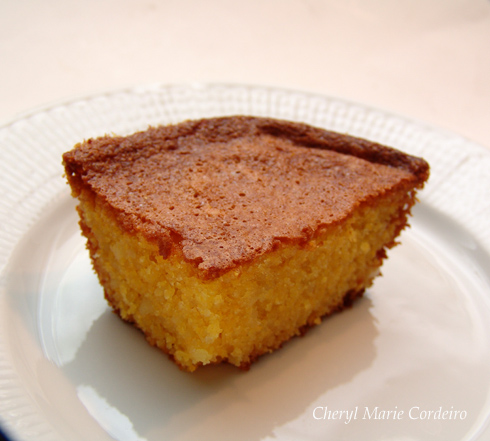
The almond sugee cake, a Singapore Eurasian favourite.
Photos © Jan-Erik Nilsson and Cheryl Marie Cordeiro for CMC, 2009
Apart from the rich fruit cake, which is characteristically heavy handedly laced in brandy, that marks Christmas and all its cool weather, sometimes even rainy festivities for the Eruasians in Singapore, the Almond Sugee or Semolina Cake, would be an all-rounder cake for festive events. This cake, in all its variations of with or without icing, nutmeg, cardamon, brandy or cognac soaked etc., is served at Eurasian Christenings, weddings, house-warming parties, New Year’s Eve parties, birthdays and anniversaries.
Admittedly, I grew up not really liking this cake, because it seemed like we had it all the time. In fact, there was no event at home that didn’t omit this cake from the menu. But nostalgia kicks in, even for tastebuds when you’re away from home and just the smell of this cake baking in the oven in my Swedish home, brings me right back to happy Christmases and everything I would associate as a Singapore Eurasian heritage.
The recipe given here comes from Wendy Hutton’s (2007), book entitled, Singapore Food: a treasury of more than 200 time-tested recipes.
Ingredients:
250g butter, softened
250g fine semolina / sugee
7 eggs, yolks and whites separated
250g castor sugar + 1 tbsp castor sugar for beating egg whites
1/2 tsp freshly grated nutmeg
1/2 tsp cinnamon powder
1 tsp vanilla essence
1/2 tsp rose essence
2 tbsp cognac or brandy
250g ground almonds
125g plain flour, sifted
Set oven at 150 deg C
*There was no mention of the use of baking powder in Hutton’s (2007) recipe, though in my version of the cake, I do use some baking powder, as my grandmother, Dorothy Cordeiro did in her recipe.
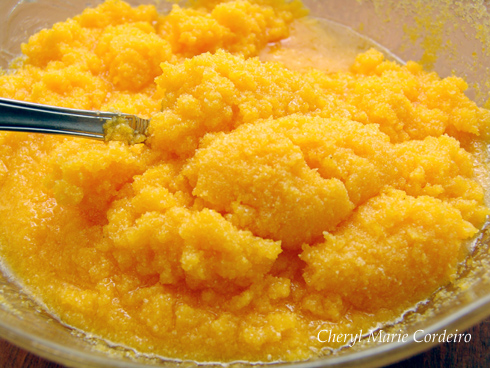
Semolina in butter.
I begin with soaking the semolina in the softened butter. How long the semolina sits in the butter is really relative. You could let it sit for an hour (as Wendy Hutton recommends), up to 4 hours (as some of my aunts recommend) or let sit in the refrigerator overnight (as my great grandmother recommended).
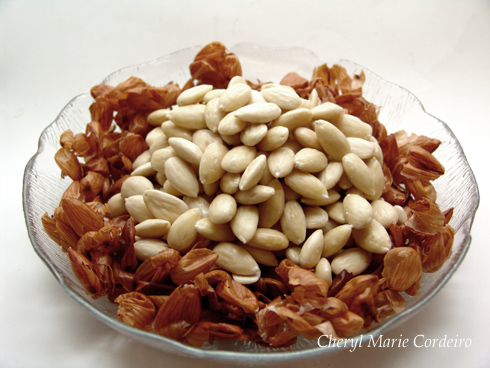
Almonds, peeled.
Then the next thing I do is to peel the almonds. This too, is relative, depending on how you want your cake to look. I have made sugee cakes with almond skin left in for colour and taste variation. But for this presentation, I did away with the peel.
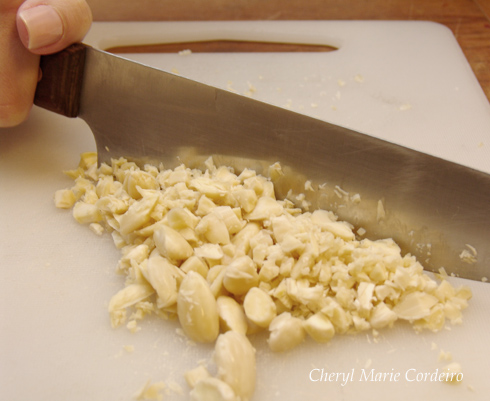
Almonds, rough chopped.
Since I prefer the cake with a little more texture and bite, I rough chop the almonds, instead of fine grinding them.
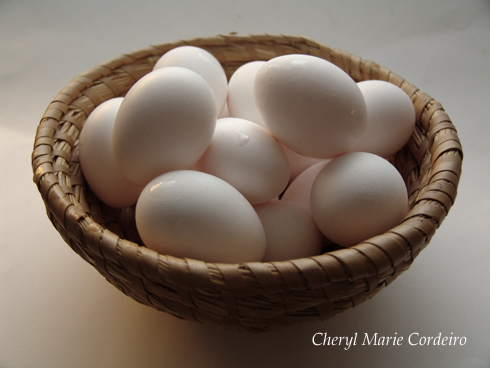
The number of eggs to this semolina cake is surprisingly many.
The number of eggs used in this cake is not for the faint hearted. I figure that goes for the amount of butter used too. But really, nobody eats an entire sugee cake at one sitting (except Uncle Ben) and I think it’s the richness of the egg yolks and butter that makes this cake one of the more unforgettable delights to melt on your palate.
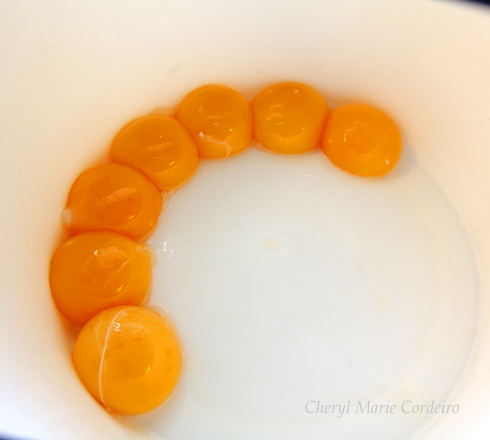
Egg yolks, separated.
I was about 7 years old when I was allowed to help with baking the sugee cake at home in Singapore. And the first task I learned was how to separate the egg yolks from the egg whites. It was a fantastic job to have because I thought it so fun to handle the sliding consistency between my fingers. I had great difficulty not breaking the egg yolks though!
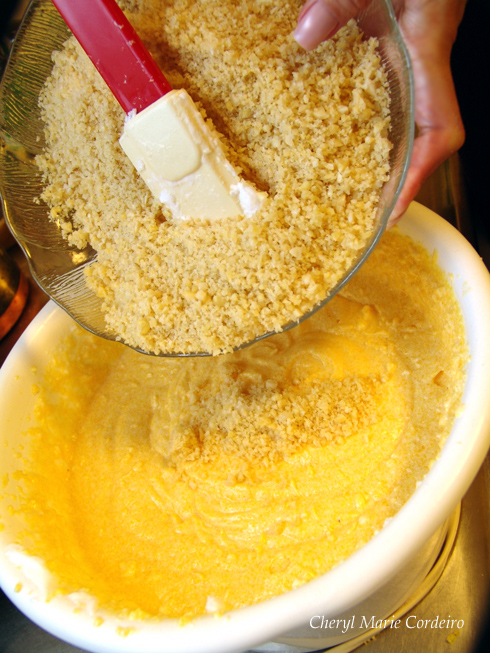
The almonds, going into the semolina batter.
Once the almonds are chopped and the semolina and butter are thoroughly married, the egg yolks are beaten with the sugar to a light consistency. In a separate bowl, beat the egg whites with the tablespoon of sugar, so that the egg whites don’t deflate easily.
Carefully mix the buttered semolina with the other dry ingredients and fold in the egg whites. Add the dash of brandy / cognac, as a last touch.
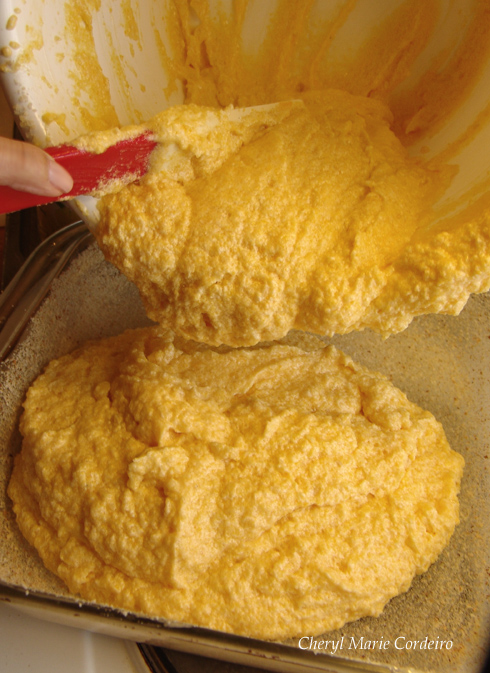
The slightly chunky batter into the baking form.
Once the batter is thorougly mixed, pour it out into a greased baking form and bake at 150 deg C till the cake is nicely browned at the top, which takes about an hour or so. If the top of the cake is turning brown too quickly, turn off the top heat to the oven and continue to bake evenly. Due to its temperamental nature, I would recommend to try to keep the oven door closed at all times during baking, as a swoosh of cool air might result in the cake deflating. If you need to check how the cake is doing, look at the top and sides of the cake. When the sides of the cake is just beginning to come away from the tin, then it’s thereabouts done.
Looking at the served sugee cake, I think most Swedes would think it a standard sugar cake or sockerkaka. A look of surprise often follows with the first bite into this cake when served in Sweden, and then the enquiries begin on the what and how.
Although the sugee cake is often served with marzipan and icing on top in my family, I think I prefer it served as is. Because my favourite bit of the cake happens to be its golden brown top, where the sugar, butter and semolina caramelises. Sheer heaven!
8 thoughts on “The Almond Sugee cake: a Singapore Eurasian heritage”